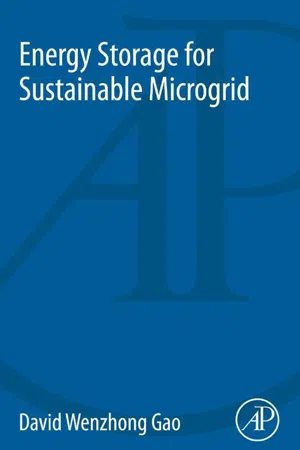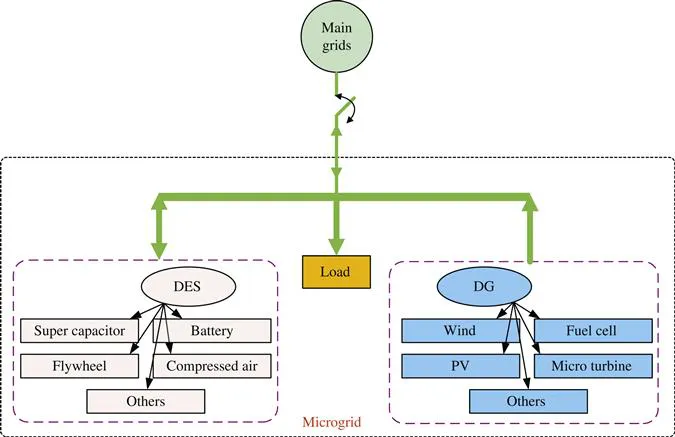
eBook - ePub
Energy Storage for Sustainable Microgrid
David Wenzhong Gao
This is a test
Share book
- 152 pages
- English
- ePUB (mobile friendly)
- Available on iOS & Android
eBook - ePub
Energy Storage for Sustainable Microgrid
David Wenzhong Gao
Book details
Book preview
Table of contents
Citations
About This Book
Energy Storage for Sustainable Microgrid addresses theissues related to modelling, operation and control, steady-state and dynamic analysis of microgrids with ESS. This book discusses major electricity storage technologies in depth along with their efficiency, lifetime cycles, environmental benefits and capacity, so that readers can envisage which type of storage technology is best for a particular microgrid application. This book offers solutions to numerous difficulties such as choosing the right ESS for the particular microgrid application, proper sizing of ESS for microgrid, as well as design of ESS control systems for proper interfacing with the microgrid.
- Explanations for major power electronic converters/technology required to achieve the desired interfacing
- Case studies on the major impacts of energy storage on microgrid
- Detailed solutions for choosing the right ESS for particular microgrid applications
- Valuable economics chapter to help evaluate entire systems
Frequently asked questions
How do I cancel my subscription?
Can/how do I download books?
At the moment all of our mobile-responsive ePub books are available to download via the app. Most of our PDFs are also available to download and we're working on making the final remaining ones downloadable now. Learn more here.
What is the difference between the pricing plans?
Both plans give you full access to the library and all of Perlego’s features. The only differences are the price and subscription period: With the annual plan you’ll save around 30% compared to 12 months on the monthly plan.
What is Perlego?
We are an online textbook subscription service, where you can get access to an entire online library for less than the price of a single book per month. With over 1 million books across 1000+ topics, we’ve got you covered! Learn more here.
Do you support text-to-speech?
Look out for the read-aloud symbol on your next book to see if you can listen to it. The read-aloud tool reads text aloud for you, highlighting the text as it is being read. You can pause it, speed it up and slow it down. Learn more here.
Is Energy Storage for Sustainable Microgrid an online PDF/ePUB?
Yes, you can access Energy Storage for Sustainable Microgrid by David Wenzhong Gao in PDF and/or ePUB format, as well as other popular books in Technology & Engineering & Power Resources. We have over one million books available in our catalogue for you to explore.
Information
Chapter 1
Basic Concepts and Control Architecture of Microgrids
This chapter discusses the basic concepts and control structures of microgrids. Nowadays, distributed generation technology is becoming increasingly mature, and is deployed as active distribution networks working cooperatively with conventional power grids. In addition, the issues of exhaustible natural resources, fluctuating fossil fuel prices and the security of electricity have encouraged governments around the world to hold positive attitudes toward the development of emerging microgrids. Future microgrids will allow high renewable penetration and become building blocks of smart grids thanks to advanced communication and information technology. As the underlying scientific and engineering research questions are being answered, there is no doubt that microgrids will play an extremely important role in future electric power and energy systems.
Keywords
Centralized control; Control architectures; Decentralized control; Energy storage system; Microgrid concepts; Microgrid protection; Renewable energy resources; State estimation
1.1 Introduction
This chapter discusses the basic concepts and control structures of microgrids. Nowadays, distributed generation technology is becoming more and more mature, and is deployed as key elements of active distribution network working cooperatively with conventional power grids. In addition, the issues of exhaustible natural resources, fluctuating fossil fuel prices and security of electricity have encouraged governments around the world to hold positive attitudes toward the development of emerging microgrids. Future microgrids will allow high renewable penetration and become building blocks of smart grids thanks to advanced communication and information technology. As the underlying scientific and engineering research questions are being answered, there is no doubt that microgrids will play an extremely important role in future electric power and energy systems.
1.1.1 Concepts of Microgrids
Power generation in the traditional power grid is highly centralized, with power and energy flowing unidirectionally from large synchronous generators through a transmission/distribution network to end-users. However, the technological issues associated with traditional electric utilities, as well as the environmental problems caused by the combustion of fossil fuels, have stimulated research and development into new power system technologies. With the emergence of distributed energy resource (DER) units, e.g., wind, photovoltaic (PV), battery, biomass, micro-turbine, fuel cell, etc., microgrid technologies have attracted increasing attention as an effective means of integrating such DER units into power systems. However, there is no clear definition of a microgrid, and the concept varies in different countries and regions. Based on the European Technology Platform of Smart Grids [1], a microgrid is a platform that facilitates the integration of distributed generators (DG), energy storage systems (ESS) and loads to ensure that the power grid can supply sustainable, price-competitive and reliable electricity. Figure 1.1 shows a typical microgrid structure, comprising DGs, such as combined heat and power unit (CHP), microturbines, PV systems, wind power systems, fuel cells; a distributed energy storage (DES) facility such as battery banks, super-capacitors, flywheels, electric vehicles; flexible loads and control devices.

Microgrids can be classified as AC and DC types. AC microgrids can be integrated into existing AC power grid, but they require quite complicated control strategies for the synchronization process in order to preserve the stability of the system. On the other hand, DC microgrids have better short circuit protection and significantly improved efficiency. Furthermore, some synchronous units (e.g., diesel generators) and some non-synchronous units (e.g., micro-turbine machines) are usually connected in the same microgrid system. As the penetration level of more DC loads (especially Plug-in Hybrid Electric Vehicles) increases, hybrid AC/DC synchronous/non-synchronous microgrids via multiple bi-directional converters will become increasingly attractive. Figure 1.2 shows a typical system structure for a hybrid AC/DC microgrid that contains power electronic interfaces and multiple DER units.

Although many types of DG units are more sustainable, a high level penetration of renewable energy resources (e.g., wind, PV) in microgrids can make maintaining grid stability and delivering reliable power challenging due to intermittency and fluctuation issues. In such cases, a DES can play an essential role in improving stability, strengthening reliability, and ensuring security. Not only can DES units be used for smoothing the fluctuations from the output of DG units, but they ...